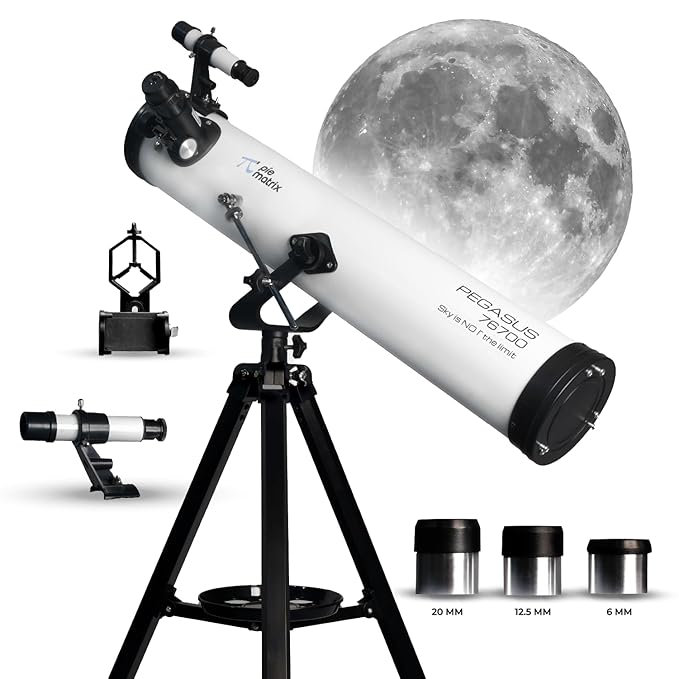Why Viewing Planets is a Unique Experience
Viewing planets through a telescope offers a unique and awe-inspiring experience. Unlike stars, planets are relatively close to Earth, allowing us to see details like the rings of Saturn, the moons of Jupiter, and the phases of Venus. This proximity makes planetary observation both accessible and rewarding for amateur astronomers.
When you observe planets, you are essentially peeking into our own solar system, gaining a better understanding of these celestial neighbors. This can be a deeply personal experience, making the vastness of space feel a little more intimate and comprehensible.
Key Features to Look For in a Planetary Telescope
A high-quality planetary telescope should have a few key features to ensure optimal viewing. First, a high focal length is crucial for magnifying distant planets. Telescopes with longer focal lengths provide better resolution and detail.
Another important feature is aperture size. A larger aperture allows more light to enter the telescope, resulting in brighter and clearer images. Additionally, telescopes with good optical quality, such as those with multi-coated lenses, can significantly enhance your stargazing experience.
Top Telescope Models for Planetary Observation
There are several telescope models that stand out for planetary observation. The Celestron NexStar 8SE is a popular choice, known for its powerful 8-inch aperture and user-friendly computerized mount. It offers excellent clarity and detail, making it ideal for viewing planets.
Another great option is the Sky-Watcher ProED 120mm Doublet APO Refractor Telescope. This model features high-quality optics and a robust mount, providing sharp and vibrant images of planets. The Orion SpaceProbe 130ST Equatorial Reflector Telescope is also worth considering, offering a good balance of performance and affordability.
Tips for Getting the Most Out of Your Telescope
To maximize your planetary viewing experience, it’s important to set up your telescope in a location with minimal light pollution. Dark skies can make a significant difference in the clarity and brightness of the planets you observe.
Additionally, allow your telescope to acclimate to the outside temperature before using it. This helps to reduce any distortions caused by temperature differences. Lastly, invest some time in learning how to properly align and calibrate your telescope. Accurate alignment can greatly enhance your ability to locate and view planets.
Additional Accessories to Enhance Your Stargazing
There are several accessories that can enhance your stargazing experience. High-quality eyepieces can provide greater magnification and clarity. Consider investing in a Barlow lens, which effectively doubles the magnification of your existing eyepieces.
Filters are also useful for planetary observation. For example, a moon filter can reduce glare when viewing the bright lunar surface, while color filters can bring out specific details on planets like Mars and Jupiter. A sturdy tripod and a star chart or astronomy app can also be helpful additions.
Pie Matrix Pegasus 76mm AZ Newtonian Reflector Telescope

About this item
- Professional-Grade Telescope for Enthusiasts: The Pie Matrix Pegasus 76700 Newtonian Reflector Telescope is the ultimate choice for both beginners and experienced stargazers, providing exceptional performance for celestial viewing and deep sky observation
- Versatile Eyepiece Options for Custom Viewing: The telescope includes 20mm, 12.5mm, and 6mm eyepieces, offering a wide range of magnification options from 35X to an impressive 235X (with the included Barlow lens), allowing you to tailor your viewing experience to your preferences
- Ideal for Astrophotography: With the included phone adapter, you can easily capture stunning images of the night sky and share your astronomical discoveries with friends and family, making it a perfect tool for budding astrophotography
- Trending and Popular Choice: The Pie Matrix Pegasus 76700 Newtonian Reflector Telescope is a highly sought-after and trending telescope among astronomy enthusiasts, offering cutting-edge features, exceptional value, and a complete package for a memorable stargazing experience
- Highly Reflective Aluminum/SiO2 Coated Mirror: Equipped with a highly reflective aluminum/SiO2 coated mirror, the Pegasus 76700 ensures crystal-clear, sharp images, enhancing your stargazing sessions with superior image quality
- Durable and Adjustable Tripod for Stability: The telescope comes with a sturdy, powder-coated black aluminum tripod that is fully adjustable, ensuring stability and ease of use in various observing conditions
- User-Friendly Alt-Azimuth Fork Mount: Featuring an Alt-azimuth (Alt-AZ) fork mount with a convenient locking mechanism, this telescope allows for smooth and precise adjustments, making it accessible and user-friendly for astronomers of all experience levels
- Large 3-Inch Aperture for Stunning Clarity: Boasting a 3-inch (76mm) aperture and a 700mm focal length, this telescope delivers detailed and breathtaking views of planets, the moon, star clusters, and prominent deep sky objects such as the Orion Nebula and Andromeda Galaxy
- Complete Box Kit for Immediate Setup: The box contains everything you need to get started, including the telescope tube, full-size aluminum tripod, Barlow lens, Phone adapter, 3 eyepieces, Moon Filter, accessory tray, finder scope, Erecting eyepiece, Travel bag, instruction manual, and a celestial space calendar, ensuring a hassle-free setup and immediate enjoyment.
- 2-Year Brand Warranty: Enjoy peace of mind with a 2-year warranty covering defects in materials and workmanship. For support, reach out to our 24/7 customer care team at +91 9355529405 or support@thepiematrix.com
FAQ
The best time to observe planets is during opposition, when a planet is closest to Earth and fully illuminated by the Sun.
To reduce light pollution, find a dark-sky location away from city lights, and use a telescope with a light pollution filter.
Both types have their advantages, but refractor telescopes are often preferred for planetary observation due to their sharp and high-contrast images.
Yes, many beginner telescopes are capable of viewing planets, especially if they have a decent aperture and focal length.
While not necessary, a computerized telescope can simplify the process of locating and tracking planets, making it easier for beginners.
